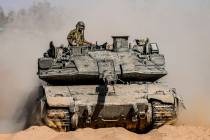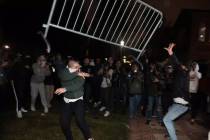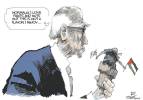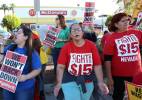Gasoline prices a bright spot in difficult economic times
Reporters don't call Denton Cinquegrana anymore.
There's just not much for the oil industry expert to discuss these days, what with gasoline prices stalled at around $2 a gallon and the price of oil staying under $55 a barrel. It's a far cry from 2008's record prices, which brought widespread pain to consumers and businesses alike.
All indicators point to Cinquegrana's phone staying quiet through the busy summer driving season. After a half-decade string of summers that forced fuel prices to all-time highs, analysts and observers expect little movement in gasoline costs in 2009's warmer months. Fuel prices shouldn't even approach the $4.25-a-gallon pinnacle they reached in 2008, experts say.
"We're just not seeing the rip-roaring moves in gasoline prices that we've seen in the past," said Cinquegrana, West Coast markets editor for the national Oil Price Information Service.
Added Linda Rafield, senior oil analyst with New York energy researcher Platts: "My definitive opinion is that we'll not see $4 a gallon this year. I'm not quite sure we'll even see $3."
That's not to say local motorists won't notice a few traditional peaks and valleys as the summertime driving season gets under way.
Michael Geeser, a spokesman for the Nevada branch of auto club AAA, said he expects the standard run-up in prices as Memorial Day approaches, followed by a plateau through June and early July, and slight price declines in July and August. But those ups and downs should show far-smaller swings than they posted in previous years, Geeser said.
Blame -- or credit -- the recession for the reprieve at the pump.
The housing slump leaves fewer consumers with the home equity that encourages discretionary spending on inessentials such as travel. Unemployment is 8.6 percent nationwide and 10.1 percent in Nevada, and that's put the brakes on commuting. Plus, consumers get cautious about spending when they aren't earning income, or when they're worried about keeping their jobs. A dip in fuel consumption follows.
The market already gave its first hint that prices won't revisit the big spikes of summers past.
Every March and April, the refineries that convert crude oil into gasoline shut down for routine maintenance and to switch production from winter fuel blends to summer mixes. In recent years, those closures yielded big leaps in gasoline prices as fuel supplies suffered temporarily. In 2008, fuel prices rose nearly 25 cents a gallon in Las Vegas amid the changeover. In 2007, springtime prices jumped about 30 cents per gallon.
That hasn't happened in 2009.
The result of this year's maintenance season? A mere 11-cent bump in prices nationally. In Las Vegas, prices actually dropped, going from $2.17 a gallon a month ago to $2.12 a gallon Thursday, according to numbers from AAA.
"We just haven't seen the huge price increases we became so used to because demand has been down for so long," Geeser said. "That dropping demand has diluted some of the increase that usually comes at this time of year."
Also helping keep fuel costs low: oil prices. Crude petroleum closed Thursday at $52.11 a barrel, about a third of what it cost at its July 11 peak of $147.27. Oil makes up more than half of a gallon of gasoline, so any easing in crude costs will filter directly down to fuel prices.
Even threats of hurricane season, which begins May 30, and political unrest among the world's bigger oil producers isn't enough to concern observers.
Forecasts call for a mild hurricane season, Cinquegrana said, and both he and Geeser agreed geopolitical uncertainty isn't strong enough to override the economy's downward pressure on demand.
Cinquegrana's forecast calls for prices to stay between $2 and $2.50 a gallon for the rest of the summer and the year. He said he "wouldn't be surprised" if fuel prices rose just another 5 cents to 10 cents a gallon in the weeks leading up to summer.
Nor does he expect any sudden economic improvements that would boost fuel consumption. Diesel demand remains 10 percent to 20 percent below its levels a year ago, and that kind of trend typically indicates a sustained slowdown in construction and trucking. With fewer contractors building and fewer manufacturers transporting goods, don't expect the economy to recover overnight and increase demand rapidly, Cinquegrana said.
What's more, crude inventories are at 16-year highs, so there's no shortage of oil. And with refineries operating at 82 percent capacity, refiners could easily handle a slight uptick in demand. That should keep a lid on prices as well, Cinquegrana said.
Geeser pointed to a simpler analysis that could mean the potential for flat prices through summer.
"If people still have no discretionary income to spend, they're much less likely to travel and push demand for gasoline up," Geeser said. "As long as unemployment is high and people are out of work, they're just not going to spend a lot of money on gas."
Contact reporter Jennifer Robison at jrobison@reviewjournal.com or 702-380-4512.
The average cost of a gallon of regular, unleaded gasoline mostly held steady amid the spring's refinery-maintenance season, which runs from early March to early April. Prices are also well below their averages a year ago:
Las Vegas
Thursday $2.12
March 9 $2.17
April 9, 2008 $3.41
Record $4.28 (June 21)
Nevada
Thursday $2.13
March 9 $2.17
April 9, 2008 $3.47
Record $4.27 (June 20)
United States
Thursday $2.05
March 9 $1.94
April 9, 2008 $3.34
Record $4.11 (July 17)
Source: AAA























